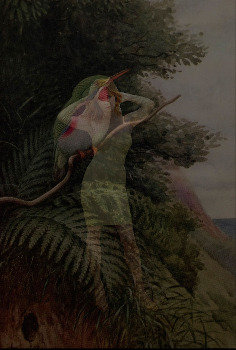Taryn Simon
dal 26/2/2014 al 11/4/2014
Segnalato da
26/2/2014
Taryn Simon
Gagosian Gallery, Beverly Hills
Birds of the West Indies. Testing the seductive surfaces of popular cinema, Taryn Simon continues her artistic process of revealing infrastructures of previously impervious cultural constructs.

In 1936, American ornithologist James Bond published the definitive taxonomy Birds of the West Indies. Writer Ian Fleming, an active bird watcher, appropriated the author’s name for his own now famous novels. He found the name “flat and colorless,” perfectly suited for a character intended to be “anonymous…a blunt instrument in the hands of the government.” This co-opting of a name was the first in a series of substitutions and replacements that would become central to the development of the Bond narrative.
Conflating Bond the ornithologist with Bond the secret agent, Taryn Simon uses the title and format of the ornithologist’s taxonomy for her own two-part body of work, Birds of the West Indies (2013–14). The first element of the work is a photographic inventory of the women, innovative weaponry and luxury cars of Bond films made over the past fifty years. The resulting images comprise an index of interchangeable variables used in the production of fantasy. Testing the seductive surfaces of popular cinema, Simon continues her artistic process of revealing infrastructures of previously impervious cultural constructs. Simon also created a film that takes as its subject Nikki van der Zyl, the most prolific agent of substitution in the Bond franchise. From 1962 to 1979, van der Zyl, an unseen and uncredited performer, provided voice dubs for over a dozen major and minor characters throughout nine Bond films. Invisible until now, van der Zyl further underscores the interplay of substitution and repetition in the preservation of myth and the construction of fantasy.
In the second element of the work, Simon casts herself as the ornithologist James Bond, identifying, photographing, and classifying all the birds that appear within the 24 films comprising the James Bond film franchise. Often the birds are incidental; they function as background for the sets they happened to fly into. Simon analyzed every scene to discover these chance occurrences. The result is a taxonomy of birds not unlike the original Birds of the West Indies. In this case, the birds are categorized by locations both actual and fictional: Switzerland, Afghanistan, North Korea, as well as the mythical settings of Bond’s missions, such as the Republic of Isthmus and SPECTRE Island. Simon’s discoveries often occupy a liminal space—confined within the fictional space of the James Bond universe and yet wholly separate from it. In their new static form, the birds often resemble dust on a negative, a once common imperfection that has disappeared in the age of Photoshop. Other times, the birds are frozen in compositions reminiscent of different genres from photographic history. Some appearing as carefully conceived still lifes, while others have a snapshot quality. Many look low-res or obscured, as though photographed by surveillance drones or hidden cameras that might have been used by MI6 within the context of the films.
Simon also collected papers, correspondence, awards, study skins, and personal effects of James Bond the ornithologist, displaying them in vitrines alongside the photographic works. The character James Bond is so embedded in public consciousness that it is difficult to disengage from the fiction and view the ornithologist’s letters and effects independent of the cinema persona. In Birds of the West Indies, Simon creates a space in which fiction and reality collide and disappear, opening up a black hole that belongs to neither realm.
The fully illustrated publication Taryn Simon: Birds of the West Indies, which includes an essay by Daniel Baumann, was published by Hatje Cantz in 2013.
Taryn Simon was born in New York in 1975. She is a graduate of Brown University and a Guggenheim Fellow. Public collections include Metropolitan Museum of Art, New York; Tate Modern, London; Centre Georges Pompidou, Paris; Museum of Fine Arts, Houston; Museum of Contemporary Art, Los Angeles; Museum of Contemporary Art, San Diego; High Museum of Art, Atlanta; and Whitney Museum of American Art, New York. She was awarded the Rencontres d’Arles Discovery Award in 2010. Major museum exhibitions include “The Innocents,” Kunst-Werke Institute for Contemporary Art, Berlin (2003, traveled to P.S.1 Contemporary Art Center, New York, Museum of Contemporary Photography, Chicago, and High Museum of Art, Atlanta, through 2006); “An American Index of the Hidden and Unfamiliar,” Whitney Museum of American Art, New York (2007, traveled to Photographer's Gallery, London, Museum für Moderne Kunst, Frankfurt, and Foam_Fotografiemuseum, Amsterdam, through 2008); “Photographs and Texts,” Milwaukee Art Museum, Milwaukee, Wisconsin (2011, traveled to Moscow House of Photography and Helsinki Museum of Art, through 2012); “A Living Man Declared Dead and Other Chapters,” Tate Modern, London (2011, traveled to Neue Nationalgalerie, Berlin, Museum of Modern Art, New York, Corcoran Gallery of Art, Washington, D.C., Museum of Contemporary Art, Los Angeles, and Ullens Center for Contemporary Art, Beijing, through 2014); and “Birds of the West Indies,” Carnegie Museum of Art, Pittsburgh (2013).
For further information please contact Alexandra Magnuson at alex@gagosian.com or at +1.310.271.9400
Press Enquiries:
Blue Medium, Inc. T. +1.212.675.1800
Contact: Deirdre Maher E. deirdre@bluemedium.com
Contact: Andy Ptaschinski E. andy@bluemedium.com
Opening reception: Thursday, February 27th, from 6:00 to 8:00 pm
Gagosian Gallery Beverly Hills
456 North Camden Drive, Beverly Hills
Hours: Tue–Sat 10-6pm
Admission free



